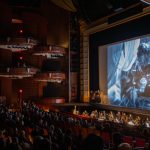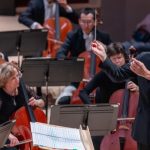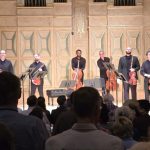September 30, 2025
Hodgson Hall, UGA Performing Arts Center
Athens, Georgia – USA
Augustin Hadelich, violin.
Georg Philipp TELEMANN: Fantasia No. 8 in E Major, TWV 40:21
Coleridge-Taylor PERKINSON: Louisiana Blues Strut: A Cakewalk
Coleridge-Taylor PERKINSON: Blue/s Forms
Eugène YSAŸE: Sonate No. 5 in G Major
Georg Philipp TELEMANN: Fantasia No. 7 in E-Flat Major, TWV 40:19
Nicolo PAGANINI: Caprice No.19 in E-Flat Major
Nicolo PAGANINI: Caprice No.16 in G Minor
Johann Sebastian BACH: Partita No. 2 in D Minor, BWV 1004
Mark Gresham | 3 OCT 2025
Exploring a program that spanned nearly three centuries and a remarkable range of styles, violinist Augustin Hadelich delivered a compelling evening comprised entirely of music for unaccompanied solo violin at the University of Georgia’s Hodgson Concert Hall on Tuesday.
From Telemann’s elegant Baroque fantasias to snapshots of contemporary jazz and blues idioms by Coleridge-Taylor Perkinson, Hadelich demonstrated both technical mastery and an almost narrative sensibility, bringing life to a repertoire that demands the performer sustain musical interest entirely alone, without the support of piano or other instruments.
The program opened with Georg Philipp Telemann’s Fantasia No. 8 in E Major, TWV 40:21, and later in the first came his Fantasia No. 7 in E-Flat Major, TWV 40:19, works that are deceptively demanding in their clarity and phrasing. Hadelich’s approach highlighted the Fantasias’ contrapuntal intricacies (implied polyphony) while allowing their lyrical qualities to breathe. Performing Telemann requires an extraordinary sense of harmonic awareness, as the violin alone must imply bass lines and inner voices while maintaining forward momentum.
Hadelich, whose previous recordings and performances of these works have been praised for balancing historical insight with contemporary expressiveness, made these centuries-old pieces sound immediate and intimate, as though the hall itself were an extension of the violin’s resonant voice.
The recital then shifted to contemporary American music as Hadelich presented Coleridge-Taylor Perkinson’s Louisiana Blues Strut: A Cakewalk (2002) and Blue/s Forms (1979), works rooted in jazz and blues idioms but written for classical solo violin. These pieces allowed Hadelich to navigate syncopation, swing, and modal inflections with the same finesse he applies to Baroque counterpoint. As with Telemann’s Fantasias, the violin alone becomes a complete ensemble: Hadelich’s left-hand articulations, bowing textures, and dynamic contrasts conjured both melody and harmonic underpinning, creating the illusion of multiple instruments speaking simultaneously.
Eugène Ysaÿe’s Sonata No. 5 in G Major, with its reflective “L’aurore” and energetic “Danse rustique,” presented another test of the violinist’s skill. Hadelich’s “L’aurore” was deeply introspective, each phrase articulated with a sense of conversational intimacy, while the “Danse rustique” burst forth with rhythmic precision and playful abandon.
Hadelich further showcased his technical prowess in two of Niccolò Paganini’s Caprices: No. 19 in E-Flat Major and No. 16 in G Minor. Even for a violinist of Hadelich’s caliber, Paganini’s demands are formidable. The music demands agility, clarity, and an expressive imagination that allows virtuosic fireworks to coexist with structural coherence. Hadelich’s performances captured the Caprices’ contrasting characters—No. 19 playful, No. 16 intense—while never sacrificing musicality to technical display.
After intermission, the recital culminated in Johann Sebastian Bach’s towering Partita No. 2 in D Minor, BWV 1004. Hadelich approached the suite with meticulous structural awareness and emotional depth, each dance movement precisely articulated yet fully expressive.
His performance of the “Ciaccona,” the Partita’s structural centerpiece and longer than the other four movements combined, was particularly arresting, gradually building its monumental trajectory with clarity, nuance, and profound emotional weight.
As an encore, Hadelich offered the serene “Largo” from Bach’s Sonata No. 3 in C Major, BWV 1005, an effectively reflective coda for the evening.
Performing an entirely unaccompanied full-length concert requires not only virtuosity but the ability to create a complete musical world with a single instrument. Hadelich exemplified that artistry. Throughout the evening, he balanced technical brilliance with expressive warmth, guiding the listener through centuries of music without losing intimacy or momentum. It was a striking reminder of the violin’s capacity, in the right hands, to command attention and imagination on its own. It also underscored Hadelich’s standing as one of the preeminent violinists of his generation. ■

Augustin Hadelich at Hodgson Hall, UGA Performing Arts Center. (UGA/Kent Hannon)
EXTERNAL LINKS:
- Augustin Hadelich: augustinhadelich.com/en
- University of Georgia Performing Arts Center: pac.uga.edu

Read more by Mark Gresham.
RECENT POSTS
 The Atlanta Opera conjures a night of enchantment as Glass’ score reawakens Cocteau’s ‘La Belle et la Bête’ • 20 Nov 2025
The Atlanta Opera conjures a night of enchantment as Glass’ score reawakens Cocteau’s ‘La Belle et la Bête’ • 20 Nov 2025 Jan Lisiecki on discipline, performance psychology, and programming for his Spivey Hall recital • 17 Nov 2025
Jan Lisiecki on discipline, performance psychology, and programming for his Spivey Hall recital • 17 Nov 2025




.png)